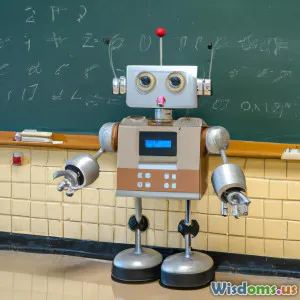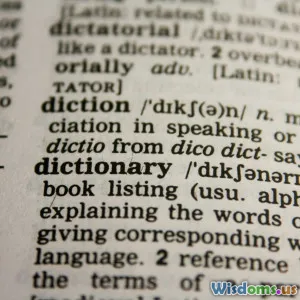
AI In TESOL Will Teachers Become Obsolete
16 min read Explore whether AI will replace TESOL teachers, examining AI's potential, limitations, and the future role of educators in language learning. (0 Reviews)
AI in TESOL: Will Teachers Become Obsolete?
Introduction: Are English Language Teachers On Borrowed Time?
A decade ago, few would have believed that intelligent machines would mark compositions, speak fluently with students, or even explain English grammar with ease. Today, speech recognition platforms, chatbots, and adaptive learning apps like Duolingo and GPT-driven tools are changing how millions learn English as a second or foreign language (TESOL/TEFL). This rapid growth of artificial intelligence in education sparks a burning question: Will TESOL teachers eventually become obsolete, mere bystanders to algorithm-driven classrooms?
This article explores the multifaceted relationship between AI and TESOL. We'll analyze what AI does well, where it falters, and—in a rapidly digitalizing world—whether the essence of teaching is at risk. Beyond the hype and anxiety, the true story is more nuanced—and perhaps more inspiring—than you might imagine.
The Rise of AI in English Language Education
A Brief Timeline of Developments
AI has not overtaken the TESOL field overnight. Its roots trace back decades to language labs, autocorrect features, and clunky grammar checkers. But in the past five years, key milestones have dramatically accelerated AI adoption:
- Speech Recognition: With advances such as Google Speech and dedicated apps like Elsa Speak, students now receive instant, accurate pronunciation feedback.
- Natural Language Processing (NLP): Automated essay graders (e.g., Criterion, Grammarly), grammar checkers, and dynamic conversation partners can analyze and respond to text nearly as well as a human interlocutor.
- Personalized Content Delivery: Adaptive platforms like Duolingo, Lingvist, and Rosetta Stone tailor exercises and exposure based on massive learning datasets.
- Real-Time Translation: Tools like DeepL and Google Translate close the gap for low-proficiency learners, allowing focus on content instead of basic comprehension barriers.
These technologies are so accessible and effective that the British Council estimated, in 2022, over 300 million students now supplement their English learning with AI-driven exercises. For learners in remote or under-resourced contexts, AI provides access and feedback previously unimaginable.
Real Classroom Example: Chatbots as Conversation Partners
In South Korea’s public schools, the government piloted AI chatbots for students to practice English conversation, wrestling with a nationwide shortage of native-speaking teachers. Early results suggested improved speaking confidence and vocabulary growth among participants. Similarly, in Vietnam, AI avatars now lead tens of thousands of language learning sessions each day.
What Can AI Currently Do Well in TESOL?
1. Immediate, Personalized Feedback
AI systems analyze student responses, pinpoint common grammar mistakes, and even suggest more natural word choices. For example, Grammarly’s Goal-Oriented Feedback can highlight overly formal or casual language based on the learner’s target audience.
2. Immersive Practice and Accessibility
With tools like Alexa and Google Assistant, individuals practice spoken English in everyday contexts—from setting reminders to telling stories—with an AI that gently corrects errors without judgment. This supports learners who may be shy or anxious about making mistakes in front of peers.
3. Tailored Curriculum Pathways
Unlike traditional, one-size-fits-all syllabi, AI can adapt exercises in real time. According to a 2023 Duolingo report, personalized scaffolding (incrementally challenging material) boosts learner retention by 19% and increases lesson completion rates.
4. Democratization and Global Reach
For isolated learners or those without access to skilled teachers, AI lowers barriers. Language learners in rural Africa or inner Mongolia can now receive feedback and structured practice that was once exclusive to private tutoring.
The Human Touch: What AI Can't Replace
Despite rapid advances, AI in TESOL has intrinsic limitations. The teacher’s role is more complex and culturally rooted than any algorithm can currently emulate.
1. Understanding Subtlety and Context
AI, at present, still struggles with the nuance of language in social or culturally sensitive situations. Humor, irony, sarcasm, and culturally specific idioms elude even the most sophisticated chatbots.
"You can train an AI to recognize grammar or correct spelling, but it doesn’t understand why the joke in one culture might offend in another," says Dr. Helen Park, Professor of Applied Linguistics at NYU.
2. Motivation and Emotional Support
Most language students experience periodic frustration, confusion, or anxiety. While AI can track progress, it cannot offer the real emotional intelligence, patience, and encouragement that humans provide.
A 2021 study published in the Journal of Educational Technology & Society revealed that students taught only by AI instructors were 30% more likely to disengage than those with access to a supportive human teacher.
3. Facilitating Deeper Communication
A language is more than grammar; it is a bridge to culture, empathy, and human connection. Teachers model pragmatic language (e.g., how to politely decline an invitation), foster discussions on world issues, and ignite intellectual curiosity. No chatbot can facilitate a nuanced classroom debate or lead a heartfelt discussion about a piece of literature in the same way.
4. Promoting Critical Thinking and Creativity
AI, by its nature, thrives on repetition and pattern recognition. In contrast, teachers encourage students to challenge assumptions, compose original arguments, and make creative connections—a skill set essential for thriving in multicultural workplaces and civic life.
Where AI Excels—And Where Teachers Still Lead
| Task | AI Proficiency | Teacher Proficiency |
|---|---|---|
| Pronunciation correction | High | High |
| Immediate grammar feedback | High | High |
| Answering predictable questions | High | High |
| Explaining idioms/cultural context | Medium | High |
| Facilitating open discussions | Low | High |
| Emotional encouragement | Low | High |
| Adapting to unique learning needs | Medium | High |
Case Study: AI-Only vs. Human-Moderated Language Classes
A 2022 experiment at a major Chinese university divided TESOL freshmen into two groups: one used an AI-only curriculum, while the other participated in blended learning with human instructors guiding discussions. The AI group outperformed on grammar quizzes by 14%, but the blended group scored 32% higher in oral proficiency, using idioms and pragmatic phrases rarely seen in AI-taught environments. Moreover, student satisfaction was twice as high among those who interacted with human teachers.
Will TESOL Jobs Disappear—Or Simply Evolve?
Automation Hype vs. Reality
Sensational headlines about “job-stealing robots” ignore key realities. While routine tasks (like grading or grammar drills) are increasingly automated, the most valued aspects of teaching—relationship-building, mentorship, curriculum design—remain profoundly human-driven.
The global demand for English language skills continues to rise: according to Education First’s 2023 report, over 2 billion people are projected to study English by 2030. While AI platforms will handle greater shares of input, skilled teachers who can leverage these tools effectively will only be more in demand.
Emerging Teacher Roles in the Age of AI
- AI Facilitator/Coach: Teachers will increasingly curate, interpret, and contextualize AI content. Instead of replacing teachers, AI can become an assistant, freeing educators to focus on communication skills, group work, and socio-cultural education.
- Content Creator: Skilled educators will design prompts, stories, project-based lessons, and sophisticated simulations that AI itself cannot generate without human creativity.
- Cultural Broker: Teachers help students navigate cross-cultural communication—an essential skill in a globalized economy that remains beyond today’s AI abilities.
"The TESOL teacher of the future is less a dispenser of facts, more a synthesizer, motivator, and human connector," asserts Andy Curtis, former President of TESOL International Association.
Professional Development: A Critical Response
Forward-thinking schools and teachers are already embracing AI as a partner. UNESCO’s 2022 policy brief emphasizes investment in teacher digital literacy and AI-fluency, ensuring educators stay at the cutting edge and leverage these tools for deeper, more meaningful learning.
Addressing Common Concerns and Misconceptions
Myth #1—AI Will Replace All Language Teachers
AI is more likely to serve as an assistant for routine feedback and repetition, not as a wholesale replacement. The most valued aspects of language teaching arise from complex, human-centric needs.
Myth #2—AI Makes English Universal, Erasing Culture
On the contrary, increased use of AI tools often reinforces the need to discuss, clarify, and respect multiple Englishes—British, American, Singaporean, Kenyan, Indian, and beyond. Teachers guide students through these variations and promote cultural literacy.
Myth #3—Only Tech-Savvy Teachers Will Thrive
While digital literacy helps, the greatest asset in TESOL will continue to be empathy, adaptability, and communication skills. Many teachers have successfully integrated AI tools with basic training and a willingness to adapt.
Example: A Rural Primary Teacher’s Story
Maria, an English teacher in rural Peru, began using a free AI pronunciation app with her students. While nervous at first, she found it allowed her to give more individual help, while also incorporating traditional group storytelling, drama, and games—methods where AI remains a supporting player.
The Future: Synergy, Not Obsolescence
Multi-Modal Classrooms
The future TESOL classroom blends the best of both worlds:
- AI-driven practice for individualized, repetitive tasks (spelling, drills, pronunciation).
- Human-led activities for discussion, games, role-plays, and project work.
This balance addresses the diverse needs of global learners, combining rapid progress with deep personal growth.
Key Skills for the Next Generation of Teachers
- Digital collaboration and evaluation of AI resources.
- Role-modeling creativity, leadership, and cross-cultural understanding.
- Facilitating complex discussions and project-based learning.
The most transformative outcomes occur when technology enhances, rather than tries to substitute, the irreplaceable craft of teaching.
Conclusion: What, Then, Is the Teacher’s Role in a World Awash with AI?
Change, while unsettling, brings opportunity. Instead of fearing obsolescence, TESOL professionals can harness AI for what it does best—delivering precise feedback, diagnosing weak points, and broadening access—while focusing their energies where humans excel: in creating meaning, social bonds, and discovery.
Teachers who adapt and innovate will find themselves not relegated to the corners of the digital classroom, but elevated—as guides, curators, and community builders. The future of English language education is not a story of human vs. machine, but of symbiosis, with AI and educators working together to help learners achieve linguistic and personal success on a global stage.
In sum: In the age of AI, it is not the teacher who will become obsolete, but rather the unimaginative classroom.
Rate the Post
User Reviews
Other posts in Artificial Intelligence
Popular Posts
















